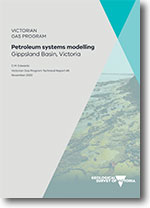VGP Technical Report 49 - Petroleum systems modelling, Gippsland Basin, Victoria.
 |
| |||||||||||||||
Product description:About the Victorian Gas Program: The Victorian Gas Program (VGP) is a comprehensive science-led program, incorporating geoscientific and environmental research to assess the risks, benefits and impacts of potential onshore conventional gas exploration and production. The program is also investigating the potential for further discoveries of onshore conventional and offshore gas in the Otway and Gippsland geological basins and assessing the feasibility of additional onshore underground gas storage in depleted reservoirs around the Port Campbell area. The VGP includes an extensive, proactive and phased community and stakeholder engagement program, through which the results of the scientific studies are being communicated. Executive summary: As part of the Victorian Gas Program (VGP), the Geological Survey of Victoria (GSV) is studying the Gippsland Basin’s petroleum systems components (reservoir, seal and source rock), to assess its petroleum prospectivity and to estimate the potential for further conventional gas discoveries onshore and offshore within Victoria’s jurisdiction. Source Geoscience Pty Ltd was engaged by GSV to construct a petroleum systems model for the Gippsland Basin. The model provides an understanding of the source rocks, the timing and volume of hydrocarbons generated and expelled, and estimated hydrocarbon migration pathways, with a focus on the onshore basin. This model informs the VGP’s prospectivity assessment and resource estimate for the onshore Gippsland Basin. A thorough investigation of the tectonic evolution of the Gippsland Basin was undertaken to create an accurate lithosphere model for the project. Well models were built using the stratigraphy provided and lithology from logs, cores and cuttings descriptions. The models were calibrated to actual temperature, vitrinite reflectance and pressure data, where available, and a location specific source rock was assigned based on the source rock potential in the well that calibrated best with the available RockEval data. The study included compilation of a geochemistry database to determine source rock type and quality. A geochemistry interpretation determined oil-source rock correlation to establish potential source facies within sequences and potential migration pathways. Well data was examined and collated to provide a database for 1D well and map-based modelling. Twenty-two 1D well models were built over the study area, along with one pseudo-well. A map-based model was built using the depth grids (Powell et al., 2020), and the 1D models imported to provide calibration points. Erosional surfaces and hiatuses were determined from seismic data, and temperature and pressure trends were included. The source rock models interpreted from geochemistry were built and kinetics assigned. Seal maps were built using field column heights, palaeogeography, lithology from wells and seal capacity testing, where available. Maturity, expulsion and other property maps (API, GOR) were then calculated. Migration modelling was carried out using multiple cases with variable parameters, including top seal capacity, expelled volumes, migration loss, carrier bed thickness, porosity and fault seal. The probability of migration and accumulation was determined and mapped. Six source rock horizons were interpreted; these were the Kingfish Formation, Volador Formation, Golden Beach Subgroup, Kipper Shale, upper Strzelecki Group, and the intra- Strzelecki Group. All modelled source rock units have reached the required maturity for hydrocarbon generation and expulsion. Although most source rock units attained optimum maturity in the offshore parts of the basin, modelling of the deeper parts of the Strzelecki Group shows that volume of expelled gas exceeds 500 bcf/km2 in part of the onshore Gippsland Basin. Timing of expulsion for the intra-Strzelecki Group source rock was modelled at around 100 million years ago (mid-Cretaceous), with gas generation and expulsion continuing to the present day. Generation and expulsion from the shallower sequences, that are somewhat dependent on variable depths of burial, was modelled at around 50 million years ago (early Eocene) and also continues to the present day. Migration modelling suggests migration pathways are present from the offshore to the onshore basin. The pathways show good calibration with existing fields, suggesting offshore generated hydrocarbons are an important input to the onshore prospectivity. Additionally, Strzelecki Group sourced hydrocarbons, particularly gas, are modelled to have migrated to mapped structures onshore, and show good calibration with soil gas anomalies, indicating multiple potential leads for further investigation. Bibliographic reference: Edwards, C.M., 2020. Petroleum systems modelling, Gippsland Basin, Victoria. VGP Technical Report 49. Geological Survey of Victoria. Download: The downloadable version of this report is supplied in PDF format (PDF 100 MB), Att A1 (XLSX 521 kb) & & Att A2 (ZIP 271 MB). Related products:
| ||||||||||||||||


